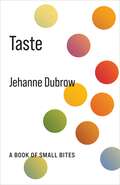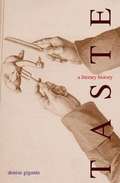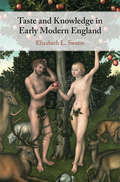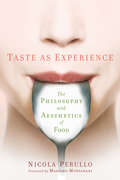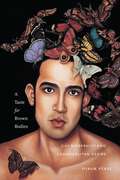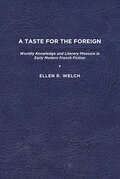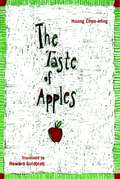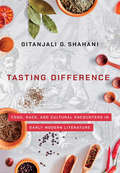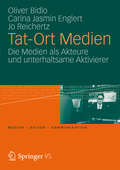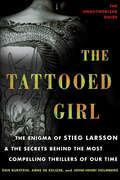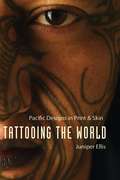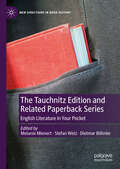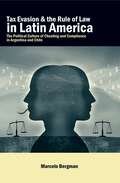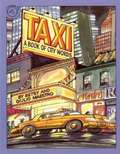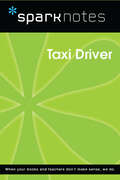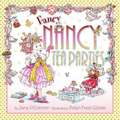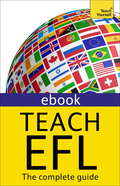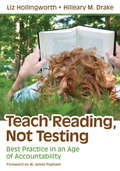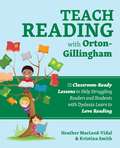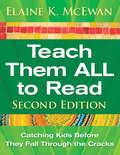- Table View
- List View
Taste: A Book of Small Bites (No Limits)
by Jehanne DubrowTaste is a lyric meditation on one of our five senses, which we often take for granted. Structured as a series of “small bites,” the book considers the ways that we ingest the world, how we come to know ourselves and others through the daily act of tasting.Through flavorful explorations of the sweet, the sour, the salty, the bitter, and umami, Jehanne Dubrow reflects on the nature of taste. In a series of short, interdisciplinary essays, she blends personal experience with analysis of poetry, fiction, music, and the visual arts, as well as religious and philosophical texts. Dubrow considers the science of taste and how taste transforms from a physical sensation into a metaphor for discernment.Taste is organized not so much as a linear dinner served in courses but as a meal consisting of meze, small plates of intensely flavored discourse.
Taste: A Literary History
by Denise GiganteWhile most accounts of aesthetic history avoid the gustatory aspects of taste, this book rewrites standard history to uncover the constitutive and dramatic tension between appetite and aesthetics at the heart of British literary tradition. From Milton through the Romantics, the metaphor of taste serves to mediate aesthetic judgment and consumerism, gusto and snobbery, gastronomes and gluttons, vampires and vegetarians, as well as the philosophy and physiology of food. The author advances a theory of taste based on Milton's model of the human as consumer (and digester) of food, words, and other commodities--a consumer whose tasteful, subliminal self remains haunted by its own corporeality. Radically rereading Wordsworth's feeding mind, Lamb's gastronomical essays, Byron's cannibals and other deviant diners, and Kantian nausea, Taste situates Romanticism as a period that naturally saw the rise of the restaurant and the pleasures of the table as a cultural field for the practice of aesthetics.
Taste and Knowledge in Early Modern England
by Elizabeth L. SwannElizabeth Swann investigates the relationship between the physical sense of taste and taste as a figurative term associated with knowledge and judgment in early modern literature and culture. She argues that - unlike aesthetic taste in the eighteenth century - discriminative taste was entwined with embodied experience in this period. Although taste was tarnished by its associations with Adam and Eve's fall from Eden, it also functioned positively, as a source of useful, and potentially redemptive, literary, spiritual, experimental, and intersubjective knowledge. Taste and Knowledge in Early Modern England juxtaposes canonical literary works by authors such as Shakespeare with a broad range of medical, polemical, theological, philosophical, didactic, and dietetic sources. In doing so, the book reveals the central importance of taste to the experience and articulation of key developments in the literate, religious, and social cultures of the sixteenth and seventeenth centuries.
Taste as Experience: The Philosophy and Aesthetics of Food (Arts and Traditions of the Table: Perspectives on Culinary History)
by Nicola PerulloTaste as Experience puts the pleasure of food at the center of human experience. It shows how the sense of taste informs our preferences for and relationship to nature, pushes us toward ethical practices of consumption, and impresses upon us the importance of aesthetics. Eating is often dismissed as a necessary aspect of survival, and our personal enjoyment of food is considered a quirk. Nicola Perullo sees food as the only portion of the world we take in on a daily basis, constituting our first and most significant encounter with the earth. Perullo has long observed people's food practices and has listened to their food experiences. He draws on years of research to explain the complex meanings behind our food choices and the thinking that accompanies our gustatory actions. He also considers our indifference toward food as a force influencing us as much as engagement. For Perullo, taste is value and wisdom. It cannot be reduced to mere chemical or cultural factors but embodies the quality and quantity of our earthly experience.
A Taste for Brown Bodies: Gay Modernity and Cosmopolitan Desire (Sexual Cultures #23)
by Hiram PérezWinner, LGBT Studies Lammy Award presented by Lambda LiteraryNeither queer theory nor queer activism has fully reckoned with the role of race in the emergence of the modern gay subject. In A Taste for Brown Bodies, Hiram Pérez traces the development of gay modernity and its continued romanticization of the brown body. Focusing in particular on three figures with elusive queer histories—the sailor, the soldier, and the cowboy— Pérez unpacks how each has been memorialized and desired for their heroic masculinity while at the same time functioning as agents for the expansion of the US borders and neocolonial zones of influence. Describing an enduring homonationalism dating to the “birth” of the homosexual in the late 19th century, Pérez considers not only how US imperialist expansion was realized, but also how it was visualized for and through gay men. By means of an analysis of literature, film, and photographs from the 19th to the 21st centuries—including Herman Melville’s Billy Budd, Anne Proulx’s “Brokeback Mountain,” and photos of abuse at the Abu Ghraib prison—Pérez proposes that modern gay male identity, often traced to late Victorian constructions of “invert” and “homosexual,” occupies not the periphery of the nation but rather a cosmopolitan position, instrumental to projects of war, colonialism, and neoliberalism. A Taste for Brown Bodies argues that practices and subjectivities that we understand historically as forms of homosexuality have been regulated and normalized as an extension of the US nation-state, laying bare the tacit, if complex, participation of gay modernity within US imperialism.
A Taste for the Foreign: Worldly Knowledge and Literary Pleasure in Early Modern French Fiction
by Ellen R. WelchA Taste for the Foreign examines foreignness as a crucial aesthetic category for the development of prose fiction from Jacques Amyot’s 1547 translation of The Ethiopian Story to Antoine Galland’s early eighteenth-century version of The Thousand and One Nights. While fantastic storylines and elements of magic were increasingly shunned by a neo-classicist literary culture that valued verisimilitude above all else, writers and critics surmised that the depiction of exotic lands could offer a superior source for the novelty, variety, and marvelousness that constituted fiction’s appeal. In this sense, early modern fiction presents itself as privileged site for thinking through the literary and cultural stakes of exoticism, or the taste for the foreign. Long before the term exoticism came into common parlance in France, fiction writers thus demonstrated their understanding of the special kinds of aesthetic pleasure produced by evocations of foreignness, developing techniques to simulate those delights through imitations of the exotic. As early modern readers eagerly consumed travel narratives, maps, and international newsletters, novelists discovered ways to blur the distinction between true and imaginary representations of the foreign, tantalizing readers with an illusion of learning about the faraway lands that captured their imaginations. This book analyzes the creative appropriations of those scientific or documentary forms of writing that claimed to inform the French public about exotic places. Concentrating on the most successful examples of some of the most important sub-genres of prose fiction in the long seventeenth century—heroic romances, shorter urban novels, fictional memoirs, and extraordinary voyages—the book examines how these types of fiction creatively appropriate the scientific or documentary forms of writing that claimed to inform the French public about exotic places. Published by University of Delaware Press. Distributed worldwide by Rutgers University Press.
The Taste of Apples (Modern Chinese Literature from Taiwan)
by Huang Huang Chun-mingFrom the preeminent writer of Taiwanese nativist fiction and the leading translator of Chinese literature come these poignant accounts of everyday life in rural and small-town Taiwan. Huang is frequently cited as one of the most original and gifted storytellers in the Chinese language, and these selections reveal his genius. In "The Two Sign Painters," TV reporters ambush two young workers from the country taking a break atop a twenty-four-story building. "His Son's Big Doll" introduces the tortured soul inside a walking advertisement, and in "Xiaoqi's Cap" a dissatisfied pressure-cooker salesman is fascinated by a young schoolgirl.Huang's characters—generally the uneducated and disadvantaged who must cope with assaults on their traditionalism, hostility from their urban brethren and, of course, the debilitating effects of poverty—come to life in all their human uniqueness, free from idealization.
Tasting Difference: Food, Race, and Cultural Encounters in Early Modern Literature
by Gitanjali G. ShahaniTasting Difference examines early modern discourses of racial, cultural, and religious difference that emerged in the wake of contact with foreign peoples and foreign foods from across the globe. Gitanjali Shahani reimagines the contact zone between Western Europe and the global South in culinary terms, emphasizing the gut rather than the gaze in colonial encounters.From household manuals that instructed English housewives how to use newly imported foodstuffs to "the spicèd Indian air" of A Midsummer Night's Dream, from the repurposing of Othello as an early modern pitchman for coffee in ballads to the performance of disgust in travel narratives, Shahani shows how early modern genres negotiated the allure and danger of foreign tastes.Turning maxims such as "We are what we eat" on their head, Shahani asks how did we (the colonized subjects) become what you (the colonizing subjects) eat? How did we become alternately the object of fear and appetite, loathing and craving? Shahani takes us back several centuries to the process by which food came to be inscribed with racial character and the racial other came to be marked as edible, showing how the racializing of food began in an era well before chicken tikka masala and Balti cuisine. Bringing into conversation critical paradigms in early modern studies, food studies, and postcolonial studies, she argues that it is in the writing on food and eating that we see among the earliest configurations of racial difference, and it is experienced both as a different taste and as a taste of difference.
Tat-Ort Medien
by Oliver Bidlo Carina Jasmin Englert Jo ReichertzDer Alltag menschlichen Zusammenlebens in modernen (nicht nur) westlichen Gesellschaften ist durch eine tiefgreifende und umfassende Mediatisierung gekennzeichnet: Medien spielen bei der kommunikativen Konstruktion von Wirklichkeit eine immer gewichtigere Rolle - vor allem dadurch, dass sie neben den Kommunikationsinhalten auch die Kommunikationsformen und das kommunikative und gesellschaftliche Handeln maßgeblich beeinflussen. Medien werden auch im Bereich der Inneren Sicherheit zunehmend eigenständige Akteure, die auf die Sicherheit ihrer Kunden achten und in deren Interesse selbst aktiv werden. Medien werden darüber hinaus auch Aktivierer, die ihre Kunden unterhaltsam dazu anhalten, sich regelkonform selbst zu führen oder aber sich in Maßen an der ,Arbeit' der Medien selbst zu beteiligen. Wir sind Zeitzeugen einer tief greifenden Mediatisierung der Sicherheitspolitik.
The Tattooed Girl: The Enigma of Stieg Larsson & the Secrets Behind the Most Compelling Thrillers of Our Time
by Dan Burstein Arne De Keijzer John-Henri HolmbergThe fascinating stories behind what have been rightly called the "hottest books on the planet": The Girl with the Dragon Tattoo, The Girl Who Played with Fire, and The Girl Who Kicked the Hornet's NestThrough insightful commentary and revealing interviews, you will enter the unique world of Lisbeth Salander, Mikael Blomkvist---and of Stieg Larsson himself---discovering the fascinating real-life experiences and incidents involving Swedish politics, violence against women, and neo-Nazis that are at the heart of Larsson's work.John-Henri Holmberg, a Swedish author and close friend of Larsson for more than three decades, provides a unique insider's look into the secrets of the author's imaginative universe, his life, and his ideas for future books---including the mysterious "fourth book" in the series, which Larsson had started but not finished at the time of his death.Included within are answers to compelling questions on every Larsson fan's mind: · What makes the Lisbeth Salander character so unique and memorable? Why have so many people from all backgrounds and with all kinds of tastes found The Girl with the Dragon Tattoo so riveting?· What are the speculations---and what is the truth---about Stieg Larsson's tragic death at age fifty, just before the publication of his novels, and the bitter battle over his legacy?· What changes were made in the plots and translations of the novels after Larsson's death---and why?· How did Larsson's early interest in science fiction and American and British crime writers feed into his creation of the Millennium trilogy? · What were Larsson's ideas for the fourth book, and are there any clues to the plots he imagined for his ten-book series? Will we meet Lisbeth's twin sister, Camilla, or any of her other seven siblings that Zalachenko tells her she has? · Does Lisbeth Salander give feminism a new definition? · What will happen in the contentious battle between Stieg Larsson's life partner, Eva Gabrielsson, and his father and brother over the future of the books, as well as the billion dollars at stake in his legacy?· Who are the emerging Swedish crime writers we should pay attention to now?· And much, much more!
Tattooing the World: Pacific Designs in Print and Skin
by Juniper EllisIn the 1830s an Irishman named James F. O'Connell acquired a full-body tattoo while living as a castaway in the Pacific. The tattoo featured traditional patterns that, to native Pohnpeians, defined O'Connell's life; they made him wholly human. Yet upon traveling to New York, these markings singled him out as a freak. His tattoos frightened women and children, and ministers warned their congregations that viewing O'Connell's markings would cause the ink to transfer to the skin of their unborn children. In many ways, O'Connell's story exemplifies the unique history of the modern tattoo, which began in the Pacific and then spread throughout the world. No matter what form it has taken, the tattoo has always embodied social standing, aesthetics, ethics, culture, gender, and sexuality. Tattoos are personal and corporate, private and public. They mark the profane and the sacred, the extravagant and the essential, the playful and the political. From the Pacific islands to the world at large, tattoos are a symbolic and often provocative form of expression and communication.Tattooing the World is the first book on tattoo literature and culture. Juniper Ellis traces the origins and significance of modern tattoo in the works of nineteenth- and twentieth-century artists, travelers, missionaries, scientists, and such writers as Herman Melville, Margaret Mead, Albert Wendt, and Sia Figiel. Traditional Pacific tattoo patterns are formed using an array of well-defined motifs. They place the individual in a particular community and often convey genealogy and ideas of the sacred. However, outside of the Pacific, those who wear and view tattoos determine their meaning and interpret their design differently. Reading indigenous historiography alongside Western travelogue and other writings, Ellis paints a surprising portrait of how culture has been etched both on the human form and on a body of literature.
The Tauchnitz Edition and Related Paperback Series: English Literature in Your Pocket (New Directions in Book History)
by Melanie Mienert Stefan Welz Dietmar BöhnkeThe Tauchnitz Edition and Related Paperback Series: English Literature in Your Pocket unites a broad variety of interests and different perspectives concerning the legacy of the Tauchnitz Edition in particular and English language paperback series in general. It provides an international and interdisciplinary approach to the 'paperback revolution' as part of media culture throughout the 19th and 20th centuries. The Bernhard Tauchnitz' Collection of British and American Authors, initiated in 1841, was not only a successful entrepreneurial endeavor but a milestone in the history of print culture as well. The Leipzig-based Tauchnitz publishers, renowned all over the world for their series of affordable pocket books in English, produced more than 5000 volumes within the course of over 100 years. Cultural and literary repercussions of this unique achievement have been far-reaching since the late 19th century. It pioneered a new way of mass-market publishing, innovative copyright arrangements and a close cooperation with many important English-language novelists of the day. Still in present times, the Tauchnitz Edition and its successors are stimulating both academic research in various fields and the enthusiasm of collectors and readers.
Tax Evasion and the Rule of Law in Latin America: The Political Culture of Cheating and Compliance in Argentina and Chile (G - Reference, Information and Interdisciplinary Subjects)
by Marcelo BergmanFew tasks are as crucial for the future of democracy in Latin America—and, indeed, in other underdeveloped areas of the world—as strengthening the rule of law and reforming the system of taxation.In this book, Marcelo Bergman shows how success in getting citizens to pay their taxes is related intimately to the social norms that undergird the rule of law. The threat of legal sanctions is itself insufficient to motivate compliance, he argues. That kind of deterrence works best when citizens already have other reasons to want to comply, based on their beliefs about what is fair and about how their fellow citizens are behaving. The problem of "free riding," which arises when cheaters can count on enough suckers to pay their taxes so they can avoid doing so and still benefit from the government’s supply of public goods, cannot be reversed just by stringent law, because the success of governmental enforcement ultimately depends on the social equilibrium that predominates in each country. Culture and state effectiveness are inherently linked.Using a wealth of new data drawn from his own multidimensional research involving game theory, statistical models, surveys, and simulations, Bergman compares Argentina and Chile to show how, in two societies that otherwise share much in common, the differing traditions of rule of law explain why so many citizens evade paying taxes in Argentina—and why, in Chile, most citizens comply with the law. In the concluding chapter, he draws implications for public policy from the empirical findings and generalizes his argument to other societies in Africa, Asia, and Eastern Europe.
Taxi: A Book Of City Words
by Betsy Maestro Giulio MaestroThe reader is introduced to such typical city words as "theater,""museum," "office building," and "train station" as a taxi travels through a hectic workday in and around the city.
Taxi Driver (SparkNotes Film Guide)
by SparkNotesTaxi Driver (SparkNotes Film Guide) Making the reading experience fun! SparkNotes Film Guides are one-stop guides to great works of film–masterpieces that are the foundations of filmmaking and film studies. Inside each guide you&’ll find thorough, insightful overviews of films from a variety of genres, styles, and time periods. Each film guide contains:Information about the director and the context in which the film was made Thoughtful analysis of major characters Details about themes, motifs, and symbols Explanations of the most important lines of dialogue In-depth discussions about what makes a film so remarkable SparkNotes Film Guides are an invaluable resource for students or anyone who wants to gain a deeper understanding of the great films they know and love.
Taylor Swift by the Book: The Literature Behind the Lyrics, from Fairy Tales to Tortured Poets
by Rachel Feder Tiffany TatreauFrom a Robert Frost poem on her debut album to the myth of Cassandra on The Tortured Poets Department, Taylor Swift&’s lyrics are filled with literary connections.Make sure you're catching them all with this expert guide to the novels, poems, and plays that influence her songwriting.Let a literature professor and a musical theater artist guide you through the Taylor Swift canon—from Shakespeare to the Brontë sisters to Daphne du Maurier! Learn what "New Romantics" has to do with the old RomanticsGet to know the Gothic monsters haunting MidnightsSpot Taylor's many Great Gatsby referencesDiscover what Taylor Swift and Emily Dickinson have in commonAnd find your new favorite tortured poet!Packed with fun facts, entertaining analysis, and literary-themed playlists that fans will love, Taylor Swift by the Book will turn anyone from a Taylor Swift lover into a Taylor Swift scholar.With full-color illustrations highlighting the literary eras of Dr. Swift (yes, she has an honorary PhD), it&’s a perfect gift for the Swiftie in your life.
A Taytsh Manifesto: Yiddish, Translation, and the Making of Modern Jewish Culture
by Saul Noam ZarittA Taytsh Manifesto calls for a translational paradigm for Yiddish studies and for the study of modern Jewish culture. Saul Noam Zaritt calls for a shift in vocabulary, from Yiddish to taytsh, in order to promote reading strategies that account for the ways texts named as Jewish move between languages and cultures. Yiddish, a moniker that became dominant only in the early twentieth century, means “Jewish” and thus marks the language with a single identity: of and for a Jewish collective. In contrast, this book calls attention to an earlier and, at one time, more common name for the language: taytsh, which initially means “German.” By using the term taytsh, speakers indicated that they were indeed speaking a Germanic language, a language that was not entirely their own. In time, when the word shifted to a verb, taytshn, it came to mean the act of translation. To write or speak in Yiddish is thus to render into taytsh and inhabit the gap between languages.A Taytsh Manifesto highlights the cultural porousness that inheres in taytsh and deploys the term as a paradigm that can be applied to a host of modern Jewish cultural formations. The book reads three corpora in modern Yiddish culture through the lens of translation: Yiddish pulp fiction, also known as shund (trash); the genre of the Yiddish monologue as authored by Sholem Aleichem and other prominent Yiddish writers; and the persistence of Yiddish as a language of vulgarity in contemporary U.S. culture. Together these examples help revise current histories of Yiddish while demonstrating the need for new vocabularies to account for the multidirectionality of Jewish culture. A Taytsh Manifesto develops a model for identifying, in Yiddish and beyond, how cultures intertwine, how they become implicated in world systems and empire, and how they might escape such limiting and oppressive structures.
!Te Toca!: A New Communicative Spanish Course
by Mark Allinson Richard Pym""Languages are best learned when real-world information becomes the focus of students' activities. In this respect, !Te Toca! definitely encourages advanced learners to focus on exchanging real-life information about the world around them. Moreover, since the topics and issues presented in the book are controversial in nature, they seem especially appealing to college students."" Dr Maria Jesus Amores, University of West Virginia!Te Toca! is a thoroughly innovative approach to advanced language learning. Imaginative, exciting and fun, it uses language simulations to take students into a virtual Spanish-speaking world where they adopt a new Spanish or Latin-American identity. Creating a learning environment in which they need to use Spanish to solve a problem or engage in debate, the language simulations draw and expand on students' linguistic, communication, and information-gathering skills.Covering a variety of engaging topics, the simulations literally put the students centre-stage, requiring them to think on their feet and speak exclusively in Spanish. The topics revolve around contentious issues and each chapter includes a simulation exercise with all its associated documents, as well as a lead text, comprehension questions, a guide to relevant points of functional grammar, associated exercises, a glossary of terms, and suggestions for written work.
Tea Parties (I Can Read!)
by Jane O'Connor<P>Ages 4-7 <P>You're invited! <P>Join in the fun with hostess extraordinaire Fancy Nancy! With a little imagination, you too can create an exquisite tea party that is perfect for your friends and family. <P>R.S.V.P. oui, oui, oui! <P>"Whenever you feel like celebrating, that's the perfect time for a tea party!" - FANCY NANCY <P>Now FANCY NANCY, hostess extraordinaire, shares all her favorite tea-party tips with you, from what to wear, which refreshments to serve, and how to make absolutely everything--even paper plates and plastic spoons--trés elegant! Before you can say "Ooh la la!" you too will be hosting tea parties that are the talk of the neighborhood!
Teach English as a Foreign Language (New Edition): eBook
by David RiddellThis new edition of Teach EFL is the ultimate practical reference guide to teaching English as a Foreign Language. 'Riddell's book is a classic - it answers all those questions new language teachers have....covers an amazing amount in a clear accessible way.'David Carr, Director of Teacher TrainingInternational House LondonThis book is packed with information on:-effective teaching techniques.-sound classroom management.-practical lesson planning.-successful job hunting and career development.This is an indispensable book for all new and experienced EFL teachers: a step-by-step guide on what to teach and how to teach it. This edition has been fully revised to include:-up-to-date information on technology as an aid to learning. -comprehensive information on the increasingly popular task-based learning.-invaluable advice on making the transition from learning to teaching.-clear guidance on ongoing professional development.-useful examples of teaching in different international contexts.Rely on Teach Yourself, trusted by learners for over 75 years.
Teach Reading, Not Testing: Best Practice in an Age of Accountability
by Professor Liz Hollingworth Hilleary M. DrakeTeaching IS rocket science—and you are the pilot! The authors reinforce what teachers already know—test preparation worksheets and drill-and-kill activities do not make children into lifelong readers. This book’s conscientious approach to reading instruction combines an insider perspective on the development of high-stakes tests with classroom experience in achieving successful reading outcomes at the elementary and secondary levels. Their research-based methodology is based on five key components: Aligning instruction to the state or national core standards Using formative assessment Connecting units to real-world contexts Motivating students effectively Holding on to best practice in literacy instruction
Teach Reading with Orton-Gillingham: 65 Classroom-Ready Lessons to Help Struggling Readers and Students with Dyslexia Learn to Love Reading
by Kristina Smith Heather MacLeod-VidalGive young readers the tools they need to improve reading fluency and master letter-sound relationships with this teacher-friendly book of multisensory lessons based on the proven Orton-Gillingham (OG) reading approach. Bringing Orton-Gillingham and multisensory teaching into your classroom has never been easier. With this big book of easy-to-follow lesson plans, you can help your struggling students or those with dyslexia start reading today. Teach Reading with Orton-Gillingham offers research-based suggestions and instructions to make reading multisensory and engaging. Whether it&’s using sand or shaving cream, there are tons of fun, proven ideas and strategies to help your students better understand key concepts like letter-sound relationships. With 9 unique units and 72 different lesson plans, each unit will include lessons, tips, pictures, reference charts, suggested teaching timelines, and more resources. Also included are strategies for customizing this approach, whether you&’re working one-on-one, within small groups, or in a whole-class setting.
Teach Reading with Orton-Gillingham: A Companion Guide with Dictation Activities, Decodable Passages, and Other Supplemental Materials for Struggling Readers and Students with Dyslexia
by Kristina Smith Heather MacLeod-VidalA Simon & Schuster eBook. Simon & Schuster has a great book for every reader.
Teach Them ALL to Read: Catching Kids Before They Fall Through the Cracks (2nd Edition)
by Elaine K. McEwan-AdkinsFeaturing vignettes, graphic organizers, instructional strategies, up-to-date research, and more, this updated bestseller helps educators understand the most effective ways to teach all students to read.
Teach This Poem, Volume I: The Natural World
by Madeleine Fuchs Holzer The Academy of American PoetsInstill a love of poetry in your classroom with the illuminating and inviting lessons from Teach This Poem classroom activities. Co-published with the Academy of American Poets, the leading champion of poets and poetry in the US, this book is an accessible entry-point to teaching poetry and fostering a poetic sensibility in the classroom.Each lesson follows a consistent format, with a warm-up activity to introduce the chosen poem, pair-shares, whole class synthesis, related resources, oral readings, and extension activities. Curated by the AAP, the poems are chosen with an eye toward fostering compassion and representing diverse experiences. Understanding that poetry is a powerful way of seeing the world, the volumes are organized thematically: Volume I is centered on the natural world and Volume II on equality and justice.Aligned with current standards and pedagogy, the lessons in this poem will inspire English teachers and their students alike.
